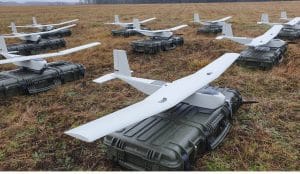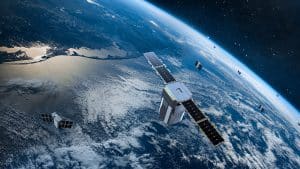Drones have become a pivotal force in the retail sector today. They offer advantages such as cost reduction, time-saving, enhanced customer experiences, improved efficiency, and heightened safety.
Last-mile drone deliveries are proving to be immensely useful in regions where road transportation is challenging or infrastructure is unreliable.
The emerging market for delivery drones is driven by surging consumer demand for expedited deliveries, and a mounting emphasis on reducing carbon emissions. Combined with tech advances, unmanned aerial vehicles are increasingly supplanting traditional delivery routes, signaling a new era in contemporary logistics.
Whether it be seamless shopping experiences during day-to-day retail operations, marketing photography, inventory management, customer behavior analysis, delivery services, transportation, or security; Drones have set themselves in stone in the retail industry.
Transforming Deliveries
Projections indicate that by the year 2028, the delivery drone market is poised to soar to an impressive valuation of $1.29 billion, exhibiting a remarkable compound annual growth rate (CAGR) of 40% from 2021 to 2028.
Drones possess a distinct advantage in providing swifter delivery than traditional transportation methods. The escalating demand for high-efficiency, particularly in same-day deliveries, coupled with intensifying competition in the retail market, impels retailers to adopt drones for speedy delivery services.
From packages to perishable items like tea or soap, drones enable local retailers and fulfillment centers to promptly deliver goods to customers.
A notable example would be Walmart through Droneup which over the past year has safely completed more than 6,000 deliveries in 7 states to customers in as little as 30 minutes. The items delivered via drone included ice cream, chicken, and lemons. 85% of items at this point meet the 10-pound payload capacity (foreseeable increase to 15 pounds) and volume requirements for drone delivery in a Walmart Neighborhood Market.

Embracing drone deliveries empowers retailers to exercise better control over their products thereby the entire logistics chain. By eliminating the need for thirdparty delivery services, retailers can closely monitor and regulate every step of the logistics process.
A good example of it is Amazon’s Newest Prime Air Delivery Drone, the MK30, which has been engineered to withstand a wider range of temperatures and light rain. The improved design also promises an extended range, offering consumers more opportunities to utilize the service.
Monitoring Supply Chain Routes & Aiding Inventory Management
Adding onto the drone delivery management in areas of poor infra and challenging road transportation, monitoring supply chain routes for disruptions is also another area that the drones can address. This could alleviate the impact on truck deliveries. These drones can monitor road conditions, construction slowdown areas, and other hazards while reporting the information to logistics managers who can quickly select alternative delivery or shipping routes.

Retailers can deploy drones equipped with sensors to locate and measure inventory across their facilities, including networks and containers. The application of drones within warehouses and fulfillment centers has proven exceptionally valuable for indoor inventory management.
Drones effortlessly navigate through unstructured large-scale environments, accessing areas that are risky to human inspectors. The use of drones to scan and check inventory in the warehouse using OCR (Optical Character Recognition), RFID (Radio Frequency Identification), and barcode readers can offer better inventory management.
An example of the above would be Ingka Group, an innovative retailer, in collaboration with the Supply Chain Development Team at Inter IKEA Group, and Verity, an indoor drone systems provider, embarked on a venture to develop a fully autonomous drone solution.
“Some retailers have tried different drone solutions, but IKEA is the first retailer to implement a fully autonomous drone solution for inventory at this scale. The solution was developed together with Verity, a provider of indoor drone systems,” says Marcus Baumgartner, Global Customer Fulfilment Manager Ingka Group, IKEA Retail (Ingka Group).
Drones streamline store inspections and assist store managers in swiftly assessing inventory levels, surpassing the efficiency of human associates. Drones aid in timely replenishment, by detecting dwindling stock, ensuring accurate and realtime inventory data.
Enhancing Retail Security through Indoor Surveillance Drones
Security stands as a paramount concern within the retail realm. Security personnel and cameras alone cannot adequately cover all areas of a retail property in event of a theft.
Drones offer a novel solution by providing real-time video surveillance of facilities, warehouses, stores, and their surroundings. They enable monitoring and inspection of critical areas and locations that cameras and security guards may not effectively cover.
Drones, also in conjunction with security sensors, can detect potentially suspicious activities. In the event of theft, drones trigger the security system, promptly notifying the security team while continuously tracking the perpetrator, sharing real-time location updates, and alerting the authorities.
The question may be asked as to why not static cameras instead of drones? Though they have their advantages, stationary cameras come with their own set of cumbersome problems, primarily being stationary. This can be a real problem as the location of the cameras can be a target for outside interference.
Cameras can’t communicate or respond to changes in instructions while autonomous drones can be very interactive. Drone fleets can fly round the clock, automatically docking in charging stations when their power runs low.
The capital expenditure on drones is also a fraction of the cost of stationary cameras or even human personnel.
A leading Robotics company, Indoor Robotics leads the way in this aspect. Their primary indoor surveillance drone Tando is designed to efficiently handle tedious, repetitive tasks to reduce false alarms, costs, and risks in various environments, especially in warehouses and retail malls, and stores.
The advantages include detecting intruders, validating false alarms, and picking up on fires or any safety hazard using sensors. MedOne, Israel’s largest data center hub, has implemented Indoor Robotics’ Tando system at its biggest server farm in Israel for improving security and safety.
Elevating Retail Marketing Photography
For effective product promotion and advertising, compelling and high-resolution product photos are crucial. However, budget constraints may hinder retailers from accessing professional photography studios or hiring expensive photographers.

Drones for commercial advertising have been huge in the retail industry. Businesses that cater to attract consumers to their products by taking very appealing pictures and videos using aerial drones for their advertisements.
Photographers or videographers also resort to taking pictures and videos to showcase a wide variety of products of a business. These can be featured on the company website, print advertisements, and billboard signage.
Unveiling Consumer Insights by Observation
Aerial drones, equipped with cameras and positioned at elevated vantage points, capture and record customer movements and behavior.
These recordings unveil shopping routes, duration spent at specific sections, and overall patterns.Retailers can harness this particular capability of drones to track and observe consumer behavior, unlocking invaluable insights for analyzing and understanding purchasing preferences and traits.
One example is Indoor Robotics mentioned previously whose drones collect and analyze real time data in order to be prepared to relay data or seek command in case of an emergency. These drones can collect data and provide retail analytics for daily operational tasks within the areas premises in real time too.
This information can also be utilized to arrange product placements, optimize floor spaces, and enhance shelf layouts. In essence, the data derived from drone observations fuels design and decoration decisions that attract more customers which in turn drives sales.
Another imminent example of it is Dronedek, a provider of a mailbox-as-a-service platform.
They have developed a solution for their food delivery problem where understanding how far the customers are and their eating times can help with Dronedek’s mailboxes receiving the food at the correct time through autonomous drones. The drones can also recharge their batteries and even keep food deliveries hot or cold.
Drones as Personal Shopping Assistants
In the world of retail, customers often invest considerable time in finding the right products. So deploying drones as shopping assistants expedites and streamlines this process. This enables customers to swiftly locate desired items, verify prices, and obtain accurate product information.

These drones are equipped with sensors, which can verify prices and cross-reference information from centralized computer databases. Employing drone shopping assistants not only reduces labor costs but also saves time for both customers and staff.
Walmart does this where the utilization of drones as Personal Shopping Assistants would facilitate the identification and price verification of products within the store, catering to the needs of customers.
The envisaged system would allow consumers to request the presence of a drone via an electronic mechanism. Once engaged, individuals would have the option to either input the desired item manually or employ the drone’s integrated scanning system to initiate the search.
In the case of product exploration, the drone would adeptly guide the user at a deliberate pace to the precise aisle and location where the desired item can be found. With their increasing adoption & progression, drones & unmanned aerial vehicles are reshaping the retail landscape and propelling a new era of efficacy and customer satisfaction in logistics and operations.









